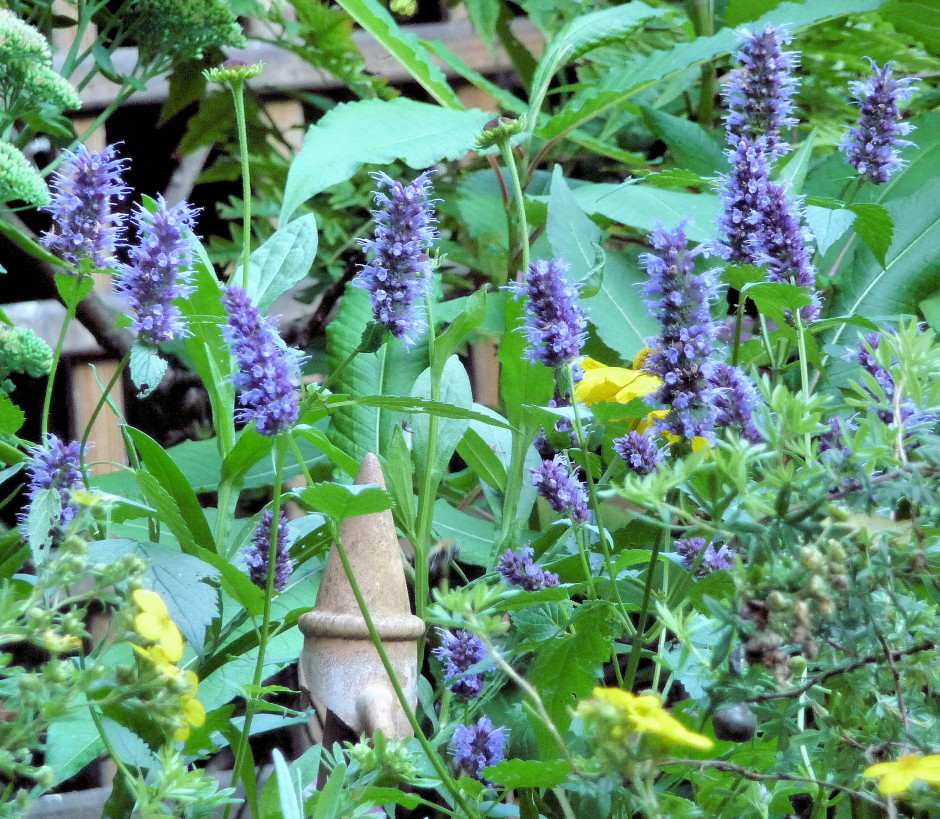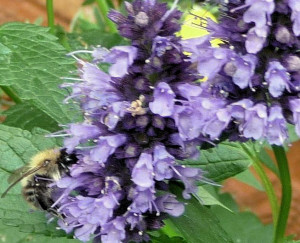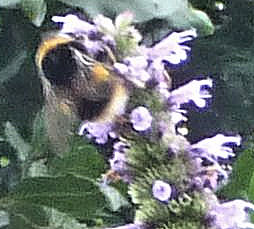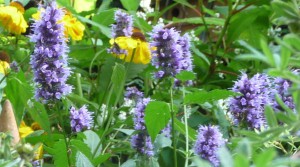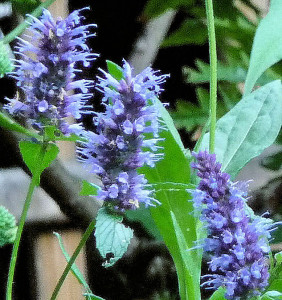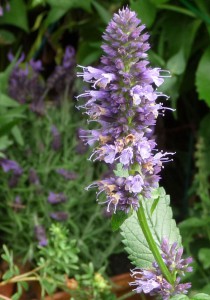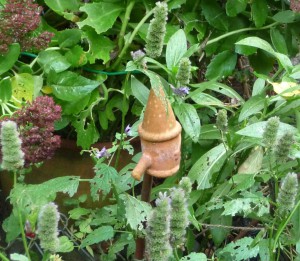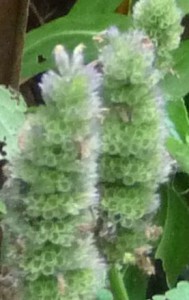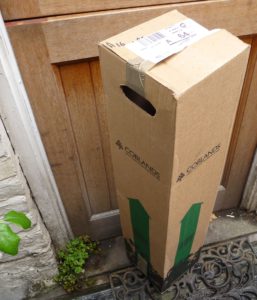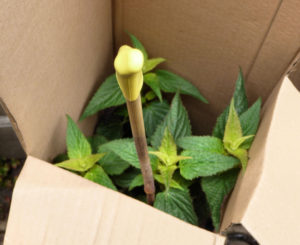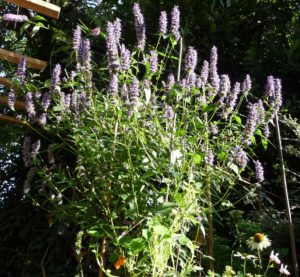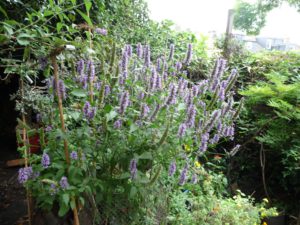AGASTACHE ‘BlackAdder’ (Giant Hyssop, Bubble Mint)
North America
Agastache ‘Black Adder’ is a striking, pollinator-friendly plant that will grow to over a metre tall, given full sun and well-drained soil.
Blue-green foliage of this aromatic plant is licorice-scented. From June to first frosts, clumps of BLUE-BLACK spires are covered with tubular LAVENDER BLUE flowers.
Bees’ favourite.
The small tubular flowers of Agastache ‘BlackAdder’ are much visited by honeybees & bumblebees. This plant appears on the internet in its own youtube video, looking fabulous in an apparently shady location. Also recommended for growing in containers.
https://www.youtube.com/results?search_query=agastache+black+adder
The City Planter, the magazine for urban gardeners, rated this one of summer’s best bee plants:
‘Agastache ‘BlackAdder’ – a great all-rounder which attracts many insects’
…”the honeybee population in London has doubled in the last four years and we now have about 5000 colonies in the Greater London area – by contrast, New York has only 600 colonies. This is despite the fact that the vegetated areas of urban back gardens, which cover 24% of the City, have declined, with almost 70% of those garden spaces now made up of hard surfaces such as decking or pavement or short cut grass. Only 11% of private back gardens have flowering plants and shrubbery which may be useful to pollinators.”
July 8 2013
The London Beekeepers Association (www.lbka.org.uk/) has their own list of recommended pollinator plants. Agastache ‘Black Adder’, they say, is especially good for honeybees:
“Giant Hyssop ‘BlackAdder’: Recent research shows this plant is the favoured source of nectar for Honey Bees. The plant produces an abundance of sweet nectar which bees make a bee-line for once discovered by the hive.”
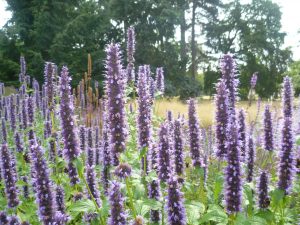
Agastache ‘Blackadder’ at Kew Gardens, Aug 2016
This photo by writer and blogger Elizabeth Hawksley was taken on an August visit to Kew Gardens. Aga ‘BlackAdder’ has been given a fine expanse to itself, & Elizabeth can attest that bees have found the spires.
“Broad Walk: the bees love this”
“I love the way that the planting has plainly been designed with bees in mind – there is a constant buzzing around the flowers – and butterflies dance around.”
Elizabeth, a friend and gardener, shares her eclectic tastes in her blog. Subjects covered have included the Secondhand Bookshop Boat on the Regents Canal, The Importance of Left Handed Mugs, & the Kings Cross Development Site – The Skip Garden & restored gasometers.
http://elizabethhawksley.com/blog/
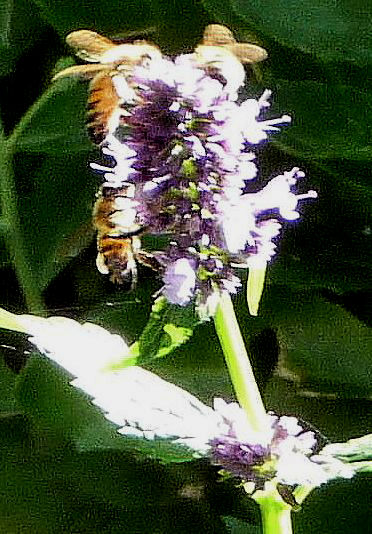 Agastache ‘Blackadder’ in Our Garden
Agastache ‘Blackadder’ in Our Garden
In 2015 we ordered two Giant Hyssop plants from Specialperennials, (a small specialist nursery in Cheshire who were doing mail order at the time.) We grew one plant here in Highbury soil, while friend Mimi trialled the other in a container on her balcony in Shepherdess Walk, near Old Street. Our plant, on its south-facing slope, got full sun for six hours a day. After possible squirrel damage, a cage was built round the plant with sticks & string. Nipping off spent blooms made our Aga Blackadder bushier, covered with flower stubs rather than spires.
Honeybees
There is a hive of honeybees in nearby Plimsoll Road. When our first Aga BlackAdder stub came into bloom, a honeybee must have found it, buzzed back to the hive & waggled the news to the others. The photo (left) shows the first bees crowding onto the stub.
Honeybees & bumblebees visited the Aga BlackAdder until 2015’s first frosts. Snails nibbled away at its lower leaves; birds or frogs who ate them could surely taste the licorice. The flowers bloomed till November in that mild London autumn.
Agastache ‘Black Adder’ Blooms on Shepherdess Walk
Mimi’s balcony faces east, where it gets morning sun. Her Giant Hyssop had to contend with its new provider going away on holiday & relying on a neighbour to water it. Even in these conditions, it too was a success. ‘It brought bees for the first time in years – which is terrific!’ said Mimi. Her photos (below) are from mid-September, after the plant had had its best moments.
We can both recommend the Aga BlackAdder to you. We have each had success, with local bees buzzing to visit the blooms.
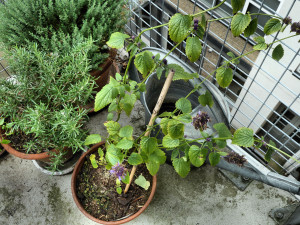
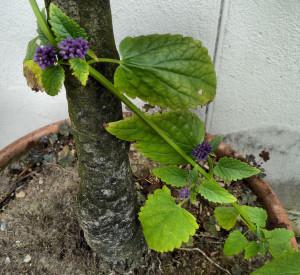
Spring 2016: No sign of Aga BlackAdder growth on Shepherdess Walk or here in Highbury, where wildlife will have eaten any seeds.
Autumn 2016: Neither of us replaced our plants this season, owing to circumstances…
davesgarden.com
On this North American website, the Agastache BlackAdder page has 34 positive reader reviews and 4 that are neutral (each referring to its prolific self-seeding). Readers say that their plants return in spring after winters of snow and ice. Our wet British winters are different, and the Giant Hyssop does not like to stand in waterlogged soil.
Dave recommends putting a paper bag over the spent spires, so the seeds when dry have a place to fall. Some of his readers have let their plants self-seed, leading to ‘groves’ of Agastache BlackAdder. Mmmmmm.
Here is one review:
On Nov 29, 2006, Rotegard from Minneapolis, MN wrote:
“Our anise hyssop patch is 2 years + in the Minneapolis LaSalle Community garden and very hardy here in zone 4. The flowers and leaves have a black licorice odor that is unrivaled for bees and butterflies. In 2005 we harvested much of the foliage for a fine melissa/agastache tea served at the Barebones Halloween festival. Mixed with chocolate mint it is the basis for a pungent licorice cordial.”
Read more: http://davesgarden.com/guides/pf/go/134/#ixzz3luq76ftt
2017:
This Agastache BlackAdder was ordered from Coblands and delivered to the front door by courier. It spent a successful season in the garden and brought in many pollinators.
https://www.coblands.co.uk/
